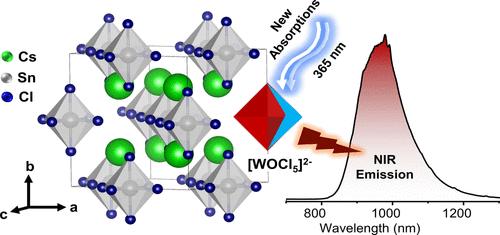W-Doped Cs2SnCl6 for Near-Infrared Emission
IF 4.6
2区 化学
Q2 CHEMISTRY, PHYSICAL
引用次数: 0
Abstract
0D perovskite derivatives such as Cs2WCl6 and Cs2WOxCl6–x have been recently shown to emit near-infrared (NIR) radiation. The d–d electronic transition of W4+/W5+ yields an NIR emission. However, the close proximity of those ions can quench the photoluminescence via concentration quenching. To address this issue, here we dilute the emission centers by doping a small amount of W into the Cs2SnCl6 0D perovskite. The results suggest that the dopant centers are [WOCl5]2– replacing [SnCl6]2– octahedra in the host lattice. The optimal 3.3% W-doped Cs2SnCl6 exhibits NIR (965 nm) emission with over 52 times higher intensity compared to that of Cs2WOxCl6–x. The suppression of concentration quenching in W-doped Cs2SnCl6 also significantly alters its temperature-dependent (7–300 K) photoluminescence compared to that of Cs2WOxCl6–x. Finally, we demonstrated NIR phosphor-converted light-emitting diodes of W-doped Cs2SnCl6 showing an output power of 10.3 mW at 400 mA. This is the first report of W doping in 0D perovskites showing its potential as an NIR phosphor.

w掺杂Cs2SnCl6近红外发射研究
d钙钛矿衍生物如Cs2WCl6和Cs2WOxCl6-x最近被证明可以发射近红外(NIR)辐射。W4+/W5+的d-d电子跃迁产生近红外辐射。然而,这些离子的接近可以通过浓度猝灭来猝灭光致发光。为了解决这个问题,我们在Cs2SnCl6 0D钙钛矿中掺杂了少量的W来稀释发射中心。结果表明,掺杂中心为[WOCl5]2 -取代主晶格中的[SnCl6]2 -八面体。最佳的3.3% w掺杂Cs2SnCl6的近红外(965 nm)发射强度是Cs2WOxCl6-x的52倍以上。与Cs2WOxCl6-x相比,w掺杂Cs2SnCl6的浓度猝灭抑制也显著改变了其温度依赖性(7-300 K)光致发光。最后,我们展示了w掺杂Cs2SnCl6的近红外磷转换发光二极管,在400 mA时输出功率为10.3 mW。这是第一次在0D钙钛矿中掺杂W,显示其作为近红外荧光粉的潜力。
本文章由计算机程序翻译,如有差异,请以英文原文为准。
求助全文
约1分钟内获得全文
求助全文
来源期刊

The Journal of Physical Chemistry Letters
CHEMISTRY, PHYSICAL-NANOSCIENCE & NANOTECHNOLOGY
CiteScore
9.60
自引率
7.00%
发文量
1519
审稿时长
1.6 months
期刊介绍:
The Journal of Physical Chemistry (JPC) Letters is devoted to reporting new and original experimental and theoretical basic research of interest to physical chemists, biophysical chemists, chemical physicists, physicists, material scientists, and engineers. An important criterion for acceptance is that the paper reports a significant scientific advance and/or physical insight such that rapid publication is essential. Two issues of JPC Letters are published each month.
 求助内容:
求助内容: 应助结果提醒方式:
应助结果提醒方式:


